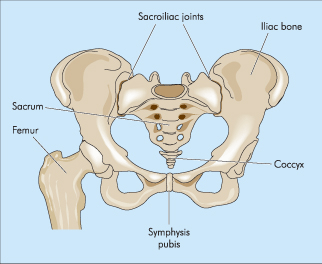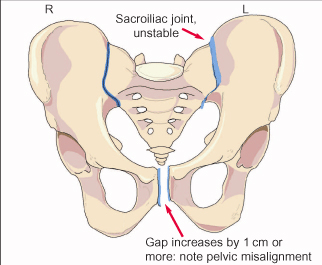Hip Pain
Chiropractic treatment is effective for hip pain. There are many reasons for having pain over the hip; one of the most common reasons is referred pain from…
Pelvic pain during pregnancy can be distressing and affect your daily life, work, and relationships. Chiropractors are trained to safely and naturally treat many of the causes of pelvic pain, including Symphysis Pubis Dysfunction (SPD)and Diastasis Symphysis Pubis (DSP) — all without the use of painkillers or NSAIDs.
Early chiropractic care can help reduce discomfort, improve mobility, and lower the risk of long-term issues.

Want to know more? Request a Callback
Or give us a call, to find out how we can help you with Pelvic Pain, Dysfunction and Chiropractic Treatment.
Book an Appointment
Schedule an appointment for Pelvic Pain, Dysfunction and Chiropractic Treatment tailored to your needs.
Pelvic dysfunction refers to a problem with the joints in your pelvis — most commonly caused by relaxation or loosening of the pelvic ligaments during pregnancy.
Although not life-threatening, pelvic dysfunction can be painful and disabling, affecting your ability to walk, stand, or carry out normal activities.
During pregnancy, your body produces a hormone called relaxin, which softens your ligaments to help the pelvis open during labour. This process begins early — relaxin levels peak at around 12 weeks — which is often when pelvic pain begins.
Not every woman experiences pelvic pain. Some may feel it only during one pregnancy, while others may have it during each pregnancy or even after giving birth.
There are two conditions under the general term of Pelvic Dysfunction: Symphysis Pubis Dysfunction and Diastasis Symphysis Pubis. The symptoms are the same, so what is the difference?
SPD occurs when the joint at the front of the pelvis (called the symphysis pubis) becomes unstable. This joint, along with the two joints at the back of the pelvis (the sacroiliac joints), helps keep your pelvis steady during movement.
When the ligaments holding these joints become too loose, excessive strain is placed on the pelvis — causing pain, instability, and difficulty moving.
Normal gap (non-pregnant): 4–5mm
Normal during pregnancy: Up to 9mm
This extra space is due to relaxed ligaments and usually returns to normal a few months after birth.

DSP is a more severe form of SPD where the gap at the pubic joint is 10mm or more, often with misalignment of the bones. This is confirmed by MRI, ultrasound, or x-ray (post-partum) and may require longer recovery time.

DSP means an abnormally wide gap is present between the two pubic bones at the symphysis pubis, diagnosed conclusively by investigation such as x-ray (post-partum), ultrasound or an MRI scan (magnetic resonance imaging).
An abnormal gap is considered to be 10mm or more, sometimes with the two bones being slightly out of alignment. This abnormal gap remains evident after the time that the joint should have regained the normal non-pregnant width.

SPD is often caused by a combination of pregnancy hormones and biomechanical strain. Some women may be more prone to it, especially if they:
Have had more than one pregnancy
Are carrying a large baby
Had previous pelvic injuries
Have a history of lower back or sacroiliac pain
Have flexible joints
Each woman experiences SPD differently, and pain levels don’t always match the severity of the joint separation. Symptoms may include:
Pain over the pubic bone (burning, stabbing, or bruising)
Lower back or hip pain
Pain that spreads to the inner thigh or groin
Clicking or grinding in the pelvic area
Waddling or shuffling when walking
Difficulty moving your legs apart (e.g. getting out of a car)
Trouble with daily tasks like:
Rolling over in bed
Climbing stairs
Getting dressed
Bending, lifting, or walking for long periods
Getting into or out of a bath or car
SPD pain can start as early as 12 weeks, due to the rise in relaxin levels. It may build gradually throughout pregnancy or come on suddenly — for example, after a fall or awkward movement.
Here are some simple ways to manage SPD and reduce your pain:
Keep your legs together when getting in/out of bed or a car
Take small steps and avoid wide leg movements
Avoid crossing your legs or standing on one leg
Use a pillow between your knees when sleeping
Sit down for activities like getting dressed or preparing food
Avoid heavy lifting, vacuuming, or twisting
Use satin sheets to help turn over in bed more easily
Use a plastic bag on your car seat to help you swivel in and out
Avoid high-impact exercises (especially breaststroke swimming)
Take regular breaks and avoid standing for too long
Consider aquanatal classes (with caution)
Use a pelvic support belt or crutches if needed
Think through each task before you do it
Organize your day to reduce unnecessary movement
Accept help when it’s offered
Most importantly: listen to your body. If it hurts — don’t do it.
Chiropractic care offers a safe and natural approach to managing SPD. Your chiropractor will take a detailed history and perform an exam to diagnose your condition.
Gentle realignment of pelvic joints (sacroiliac and pubic symphysis)
Soft tissue and ligament work
Gentle release techniques (including diaphragm and pelvic floor)
Use of blocks, belts, and non-force methods like the Activator
Webster Technique (often used for breech babies)
Ice therapy
Ultrasound or low-level laser therapy
Tailored exercises and lifestyle advice
Starting treatment early can prevent SPD from becoming severe or chronic. Most women respond well to chiropractic care both during and after pregnancy — especially when pelvic misalignment is the root cause.
Chiropractic care aims to correct the source of the problem, not just mask the symptoms.
If you’re struggling with pelvic pain during or after pregnancy, chiropractic care may help restore your mobility, comfort, and confidence — naturally.